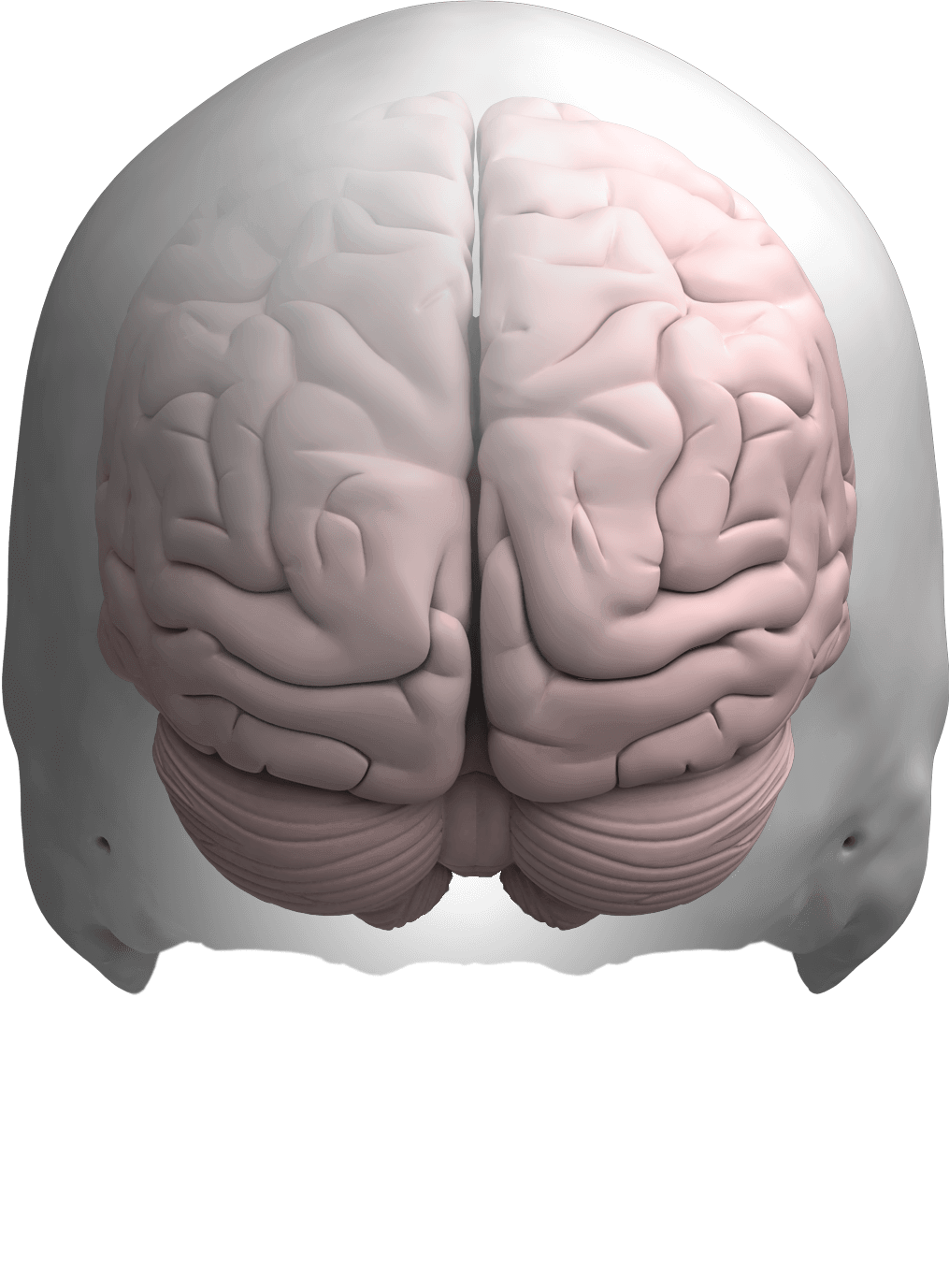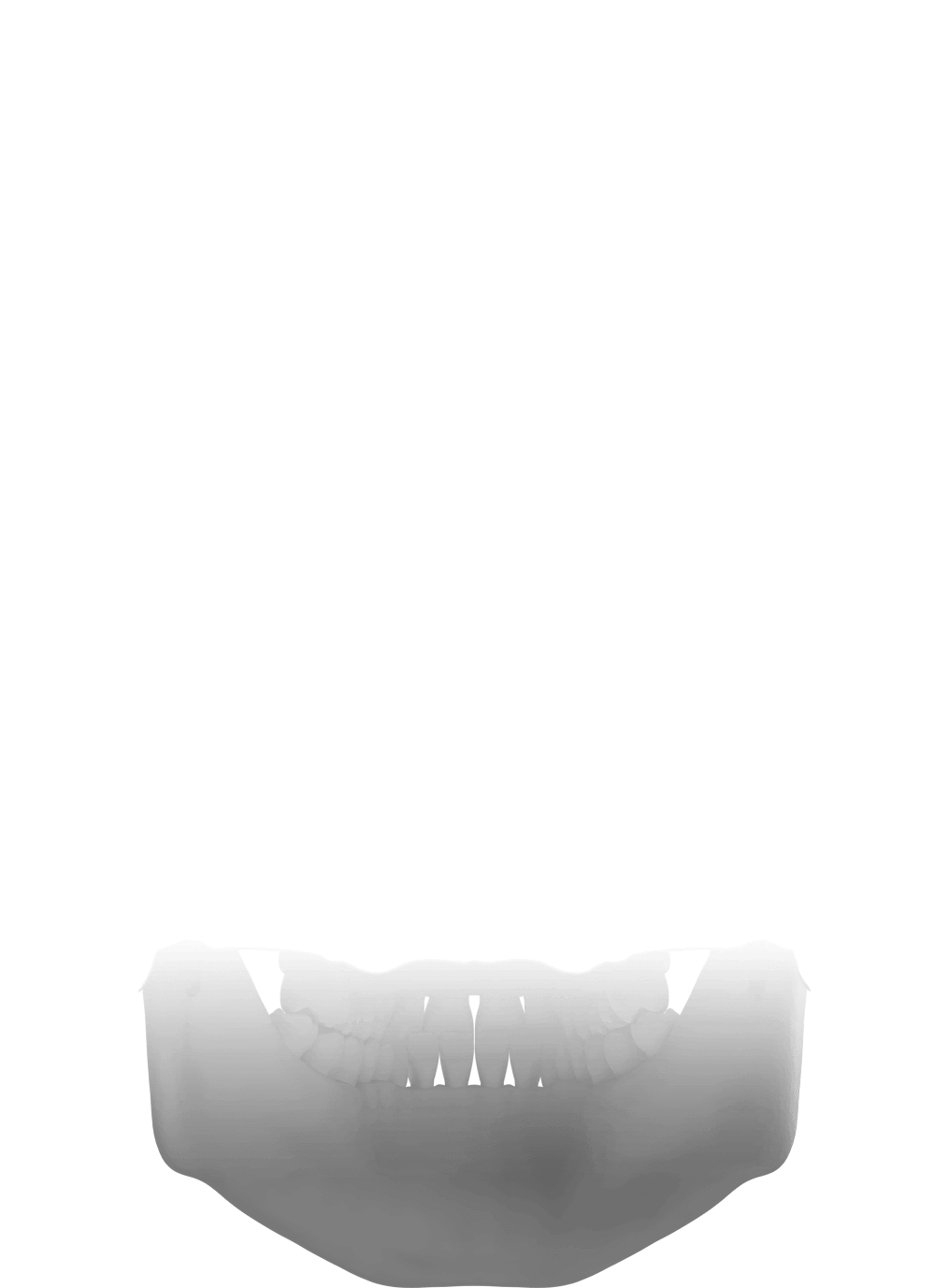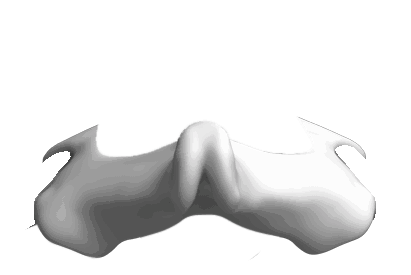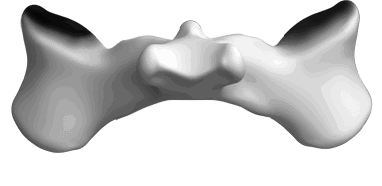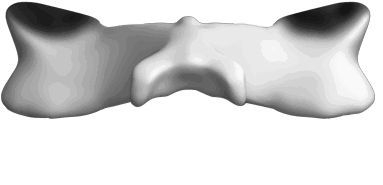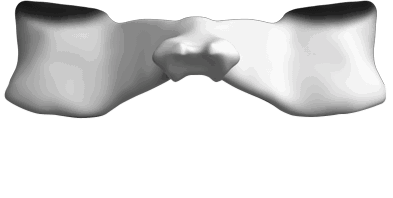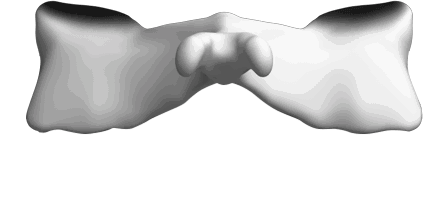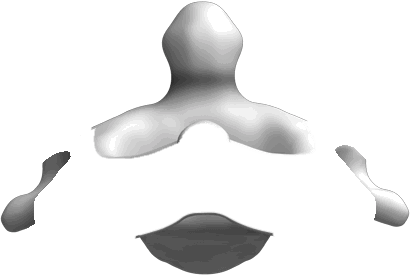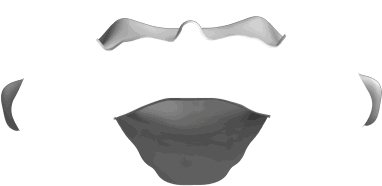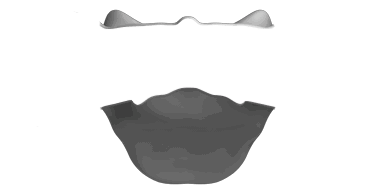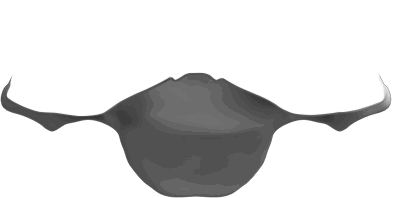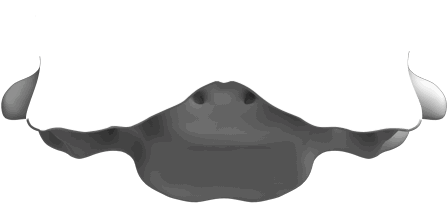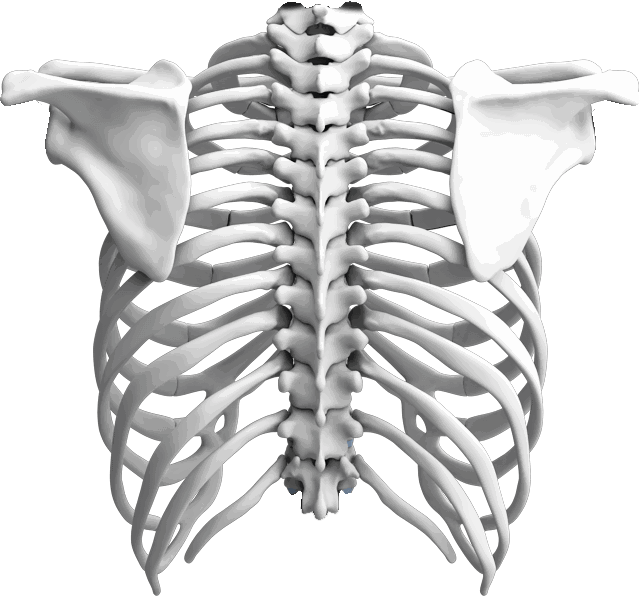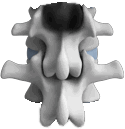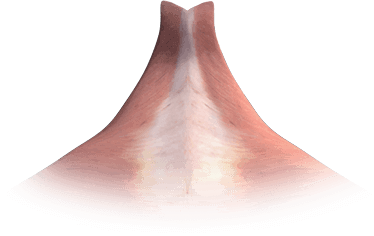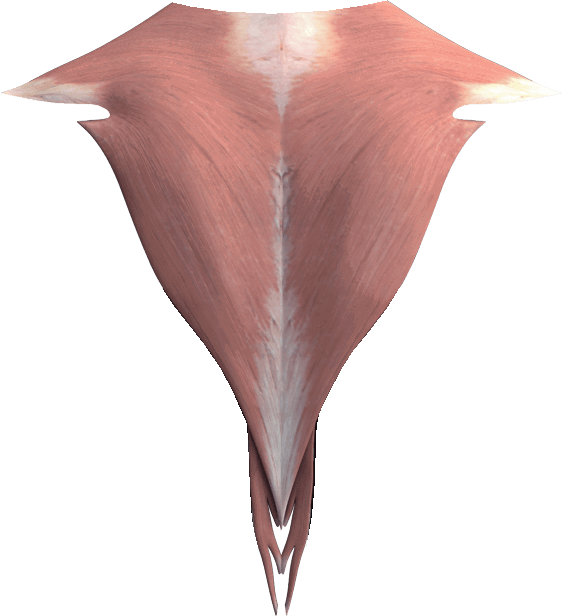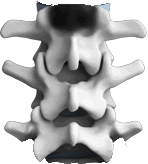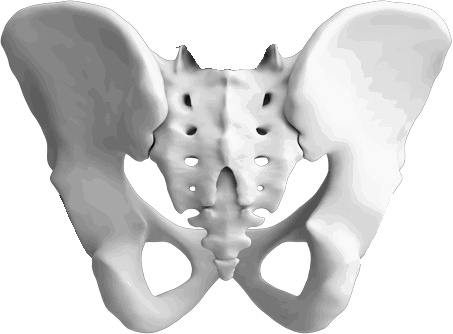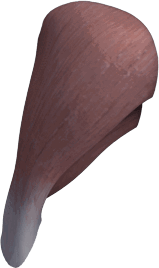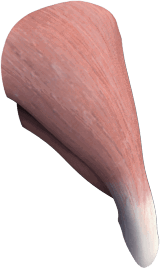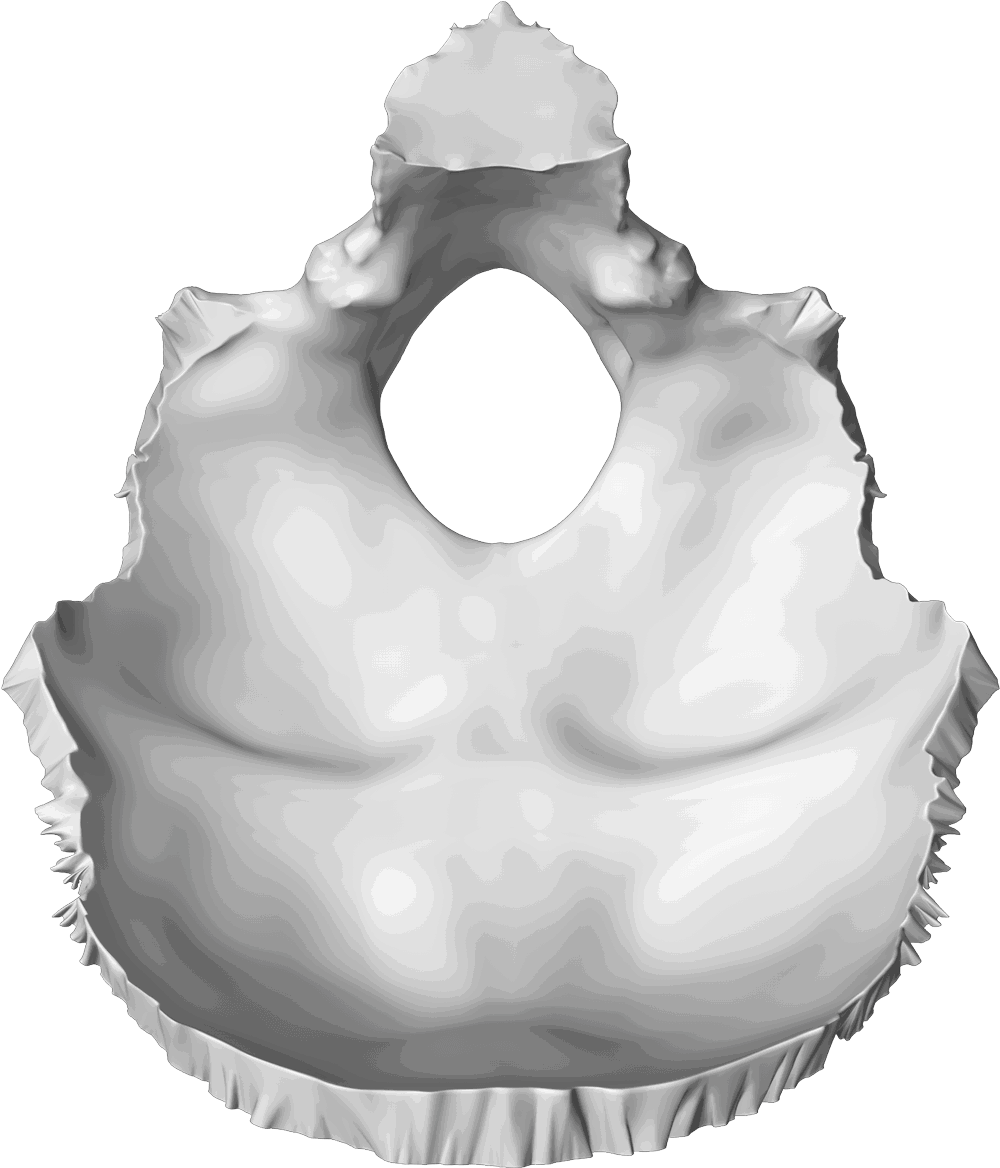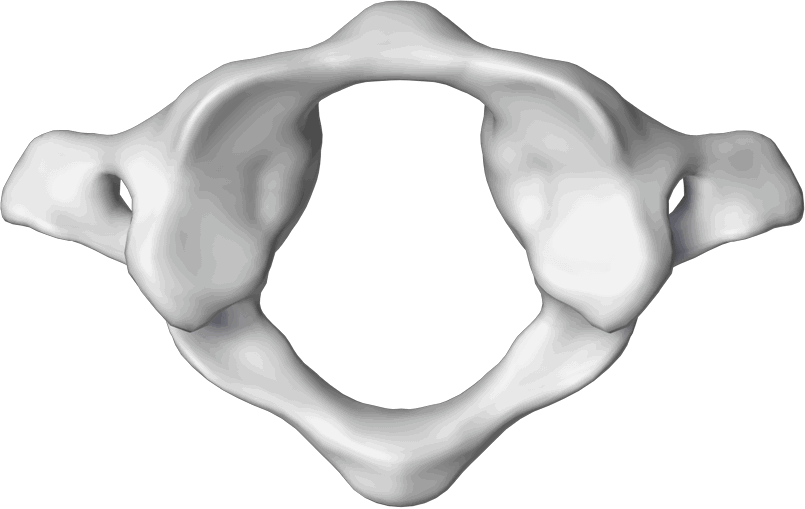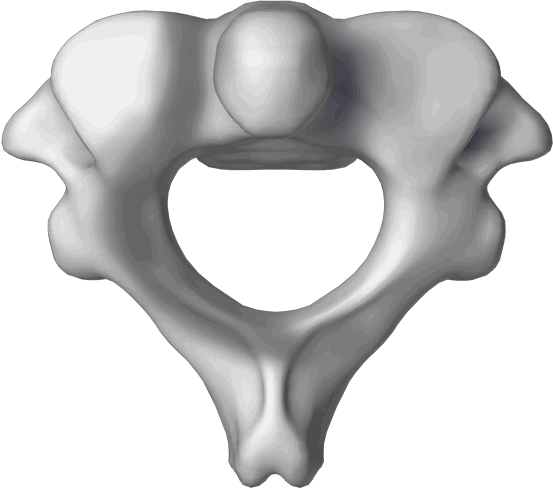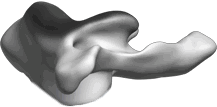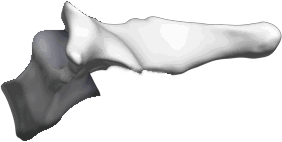Upper Neck 101
A Complex Problem
The weakest region of the human spine is where the head meets the neck! This is due to the fact that half of all of our head movements occur between the head and top two vertebrae. Injury will buckle this region of the spine in very large and complex ways, tearing loose connective tissue, ligaments and muscles responsible for maintaining normal posture and head alignment. The result is the misalignment you see here where the head, neck and top vertebra (Atlas) have shifted sideways from their normal position. This causes stress and altered nerve flow to and from the brain and creates posture distortion and body imbalance as the entire spine shifts off center. See “How Did I Get This Way?”.
A Complex & Gentle Solution
Utilizing the T.A.P. Method analysis to precisely calibrate the Atlas Orthogonal instrument developed by Dr. Roy Sweat, doctors are able to calculate the precise reduction pathway and corrective force necessary to gently bring the head, neck and atlas back into alignment (represented by the correction arrow when you click on the animation) with very little force and no “twisting” or “popping” of the neck. In fact, most patients don’t even feel the adjustment. As the correction in the upper neck is achieved the entire body is brought back into balance. Stress on posture nerves feeding the brain stem is then relieved. This is why people with problems even in the lower part of their body respond well to the T.A.P. procedure.
A Lasting Difference
The upper cervical misalignment is the most complex and difficult region of the spine to align, but when correction is achieved the results can be simply amazing. Patients notice changes throughout their entire body as normal alignment and posture is restored. It takes a tremendous amount of training to do the analysis and delivery of a quality T.A.P. alignment. Alignment is crucial in that it “reconnects” the human body’s neurological pathways.
Align Defined
The connection between the brain and body is inseparable. The brain-body connection occurs at the head and neck in a region known as the Cranio-Cervical Junction (CCJ). Our overall health depends on the quality of this connection. All vital function controls, spinal fluid, nerve signals, blood flow, and nutrients to the brain pass through this tight corridor called the CCJ. The crucial gut-brain junction also occurs at the CCJ.
Modern advances in medical science can keep the body alive without the brain, but our brains cannot live without our bodies. When our heart or lungs shut down the vital flow of oxygen to the brain is blocked. Carbon dioxide is trapped inside the brain tissues. Intact brain cells rapidly break down. Cell walls are compromised. The cells malfunction and disentegrate. Cells rapidly die. If enough of these cells die, then life in the organism as a whole is not sustainable. The brain dies. Dead brain cells cannot be resuscitated. Known science does not permit a Lazarus event of the brain.
Our entire life experience depends on the quality of communication between the brain and body. It determines our quality of life. Cognitive Scientist Guy Claxton observes that cognitive processes are not separate from senses and motor functions. As Claxton puts it: Functioning of the body, the gut, the senses, the immune system, and the lymphatic system are so inextricably linked to proper functioning of the brain that you can’t draw a line across the neck and say that above the line it’s smart and below the line it’s menial.” Clear connection of the pathways is crucial. With advanced imaging and analysis when we actually “draw that line” at the neck then measure the alignment of the functional space inside this vital CCJ corridor we often discover displacements, distortions and misalignments, and obstructions that cause a brain-body disconnect; a disconnect directly contributing to many chronic health conditions. Alignment of the CCJ corridor allows for unobstructed communication between the brain and body.
After years of caring for patients and looking at thousands of images of the CCJ , Dr. Chris Chapman is fully convinced that impedance and restrictions of flow along the vital corridor passing from brain to the body literally makes the difference on the life spectrum which has vitality at one end—and tombstone at the other. As the CCJ breaks down and distorts, nutrients cannot be delivered. Used metabolites are not cleared from the brain tissues. We lose our vitality. Misalignment robs us of our life force gradually. We are not fully alive, but rather, in the words of Billy Crystal’s character in The Princess Bride, we are “Mostly Dead.”
When the body is aligned with the head, the complex linkage between our body and brain is open and optimized. Normal function is restored throughout the brain and body. Remember, the two do not function independently. Thus, the T.A.P. Method first clears inflammation and blockage with System Lymphatique- Phase I of T.A.P. Then Phase II is to align the quarter between the brain and body opening up vital flow channels for clarity, balance, and function.
How Did I Get This Way?
How we end up in this position can often be quite complex. Trauma from sports injuries, car crashes, and falls are obvious causes. However, misalignment from dental procedures such as orthodontics, extractions, crowns, or a generally imbalanced bite can produce significant enough neuromuscular compensations to pull the craniocervical junction out of alignment as well. These issues can also stress the airway. Research shows a strong correlation between spinal conditions, airway issues, and dentofacial procedures that have resulted in malocclusion.
As you can see here, injury also twists the upper neck adding to the complexity of the misalignment and compounding stress to the brainstem. The misalignment you see is the result of one or more past injuries. Injuries can often be traced all the way back to childhood: The header off the top bunk, a tumble down the steps, the fall off the bike, hayloft, or backyard tree. Or perhaps it was that teenage gymnastics injury or auto accident? Issues can relay back as far as having had a traumatic birth. Think back and you’ll probably come up with a few possibilities of your own.
Regardless of the cause, ninety-five out of a hundred people are left with neck misalignment and posture distortion by the time they reach adulthood. After the initial pain of an injury subsides, upper neck misalignment can remain pain-free for years until a more recent injury occurs or body imbalance finally takes its toll in the form of degenerative disc disease, arthritis and/or stenosis. See “How Does This Affect My Health”.
The Nervous System "Grand Central"
The lower end of the brain is called the brainstem because it descends down into the upper neck. Every nerve that travels down the spinal cord has to pass through the fragile donut shaped vertebra that wraps around the brainstem called the Atlas! Other important nerves like our vagas nerve which provides parasympathetic tone to most of our organs passes just in front of the Atlas. This nerve can be pinched when the Atlas is twisted. For this reason, the upper neck is our neurological “Grand Central Station”: Read on—
Posture And Body Balance
The lower brainstem controls posture and balance. Misalignment and stress in the upper neck causes the muscles along each side of the spine to pull unevenly and shift the entire body off center. (See “The Bigger Picture” to learn how stress on these posture control centers affect the entire body.
Blood Pressure, Respiration and Heart Rate
The neurological centers for control of these body functions are located in the lower brain stem and can be adversely affected by upper neck misalignment. Recent research has proven that even basic Atlas Orthogonal correction helps people with high blood pressure. (Google “Atlas Orthogonal” and “blood pressure” to view the results of this research.
Sleep / Mood
Serotonin is a chemical produced in the lower brain stem. Serotonin influences various functions, including regulation of mood, sleep, appetite, muscle contraction, and some cognitive functions including memory and learning. Upper neck misalignment causing stress on the lower brain stem can have a dramatic affect on a person’s energy and overall sense of “aliveness” as is the case with Chronic Fatigue Syndrome and Fibromyalgia.
Immune Function
The Autonomic Nervous System controls all of the body functions that we don’t have to think about. The Sympathetic Nervous System is that part of our Autonomic Nervous System that becomes more active during times of stress and is often called the fight-or-flight response. Upper neck misalignment creates long-term activation of the Sympathetic Nervous System which is proven to suppress the body’s Immune System.
Digestion
The Vagus nerve is very influential in regulating digestion and elimination. This important nerve is often affected by misalignment of the upper neck because it passes right next to the Atlas vertebra as it comes down from the brain.
Head and Facial Problems
Cranial Nerve dysfunction can result in problems such as Trigeminal Neuralgia, Bells Palsy, Meniere’s Disease, Sinus Problems, Headaches, Ear Pressure, Dizziness, etc. Patients with these problems often respond to the T.A.P. procedure since cranial nerves have tracts that descend into the upper neck. T.A.P. can alleviate issues with cerebral spinal fluid and blood flow to and from the brain.
The Bigger Picture
Injury to the upper neck has a global affect on the body. When the head shifts off the top of the neck due to injury, the body’s “righting reflex” moves the body into a distorted posture to bring the head back to level. This shift causes stress and miscommunication affecting posture control centers in the lower brainstem where it passes through the top vertebra. Posture muscles that run along one side of the spine pull harder than muscles on the other side resulting in the picture you see here.
Body imbalance has a very negative long-term effect on spinal discs. When the body’s weight is not distributed evenly across the discs, premature degenerative disc disease, herniation and even a closing down of spinal nerve canals (stenosis) can result. Just as driving your car with the front end out of alignment causes premature tire wear, long term body imbalance causes your spine to age quicker. The difference between a 75 year-old on the golf course and a 75 year-old pushing a walker is usually found in their spines.
Notice the short leg, uneven hips, high shoulder and head tilt. Look closely at your friends and family as they face you and you may be able to tell if they should be referred for an evaluation. Click the animation to see how a small strategic touch just under your ear restores balance and alignment to the entire spine!
A Closer Look
Restoring alignment to the spine is a wonderful thing to experience, but how do we get it to stay in place after years of full body compensation? Here at Atlas Epigenetics, we have developed proprietary ways to encourage stabilization around an aligned body. Our second phase of treatment addresses stabilization.
Treatment Phase III: Stabilize
As discussed earlier, the vital corridor which links the brain to the body is called the Cranio-Cervical Junction (CCJ). The CCJ houses the brainstem which is in essence the body’s “fuse-box”. It encases the nerves, blood vessels and vital channels which pass from body to brain. It is held together by a variety of connecting tissues which tolderate mobility while providing stability. These tissues are Ligaments, fascia, and muscles.
Muscles both provide and limit mobility. Muscles are the dynamic stabilizers of the CCJ. Ligaments are the static stabilizers of the CCJ. Both are in constant contact with the nervous system. Muscles can be reprogrammed and balanced with a reprogramming oral appliance. Even if the ligaments are unstable from injury or overuse, muscles and their reetitive firing patterns (neurological feedback loops) can be activated to reprogram the functional relationships of the head and neck. This is true even if muscles have become imbalanced, weak, and lost their initial programming–what we call balanced alignment. Maintaining alignment is how we heal. We heal through reprogramming stabilizing tissue over time. Neuroscientist Joe Dispensa has proven that the brain is rewired by firing neurons in a different way. The architecture of the brain is literally changed when we consistently ask it to do something diferrent over a prolonged period of time. This is how we program adapted muscle memory. There are particular neurological pathways that we must access in order to accomplish this. Thus, maintaining a clear, unimpeded connection between brain and body over TIME is crucial to the healing process.
So, how does this work? It is both complex and straight-forward at the same time. Out bodies are formed to function within reason to the environments to which they are exposed. If the body is placed in a harmful or burdening environment over time it will rise to the essential needs of survival through small adaptations. That is why dysfunctional adaptations over time lead to degradation of the structures of the body that maintain our upright posture. Yes, the body organ, tissue and metabolism will actually change shape or “form” through repeated exposure to “function” or action over time. this phenomenon explains pathological adaptations found in heart disease, insulin intolerance, autoimmune conditions, bone spurs, chronic pain syndromes and almost ALL disease.
Healing Through Stability
In Dr. Chapman’s years of experience in non-surgically repositioning thousands of heads onto their soft tissue junction of joints, muscles, bone and blood vessels, he has found that head/neck stability is crucial to the healing process. Stability does not mean stiffness. True stability requires alignment. balance, and natural mobility. How do you bring this “stability” to a highly mobile and functional junction? You can’t simply put a neck brace or a halo brace on and expect to maintain dynamic functionality. Part of health is to maintain neuromuscular programs of ideal function. In order to heal effectively and completely, you must maintain motion and sensory dynamism, but at the same time, bring stability to the rehabilitating system. We accomplish this proprioceptively. In other words, we harness the body’s substantial brainstem motor loops to provide a continual barrage of postural signals to the sophisticated up-righting systems of the head and neck, upper trunk, shoulder, and jaw. These feedback loops are structurally “programmed” into specially designed intraoral appliances that are “registered” or programmed with 3D technology to influence these highly sophisticated sensory-motor loops. This is the way we can effectively bridge the gap between motion and stability—function and form. Incorrect form leads to postural compensation, imbalance, and inflammation–and unhealthy movement, or function. Ideal healthy function and form remove the body’s need for unhealthy compensation and lead to healing.
Can this be done? Can you jockey posture in a truly effective and predictable way? Taking command of the posture of the teeth enables control over the “posture” of the mandible which engages functional governance over the structures connected to the mandible—important structures like the head, tongue, shoulders, and neck. Dr. Chapman experienced this phenomenon in the early stages of his work back in 2003 when his own children underwent traditional orthodontia. As their tooth posture started to move their spines and bodies also began to move in erratic ways. Could it be that a small and seemingly forced re-posturing of teeth could alter and change the entire musculoskeletal system? This observation turned out to be more than correct. Teeth braced into position atop a misaligned Atlas and CCJ can indeed induce a myriad of chronic conditions…..and, the bite held gently into position over a perfectly aligned CCJ allows the body to heal and hold.
How Does This Affect My Health?
The brain and nervous system control and regulate every function of the body, most of which we don’t consciously think about, such as heart rate, breathing, digestion, etc. That is why the nervous system is the very first body part to develop in the mother’s womb. To live in complete health, the spine must protect the nervous system so that every cell in the body is 100% connected to the brain. Injury and damage to the spine itself interrupts the flow of energy to and from the brain. The common term for this nerve stress caused by misalignment of the spine is subluxation. As stated earlier, the upper neck is especially vulnerable to injury and subluxation. Combined with the fact that the brainstem, which is the nervous system’s “Grand Central Station”, passes through the first cervical vertebra, problems here tend to have a more detrimental effect on the entire body.
- Misalignment of the spine can cause direct pressure on the spinal cord and/or the delicate nerves that exit between each vertebrae of the spine. As a result, any body part served by these nerves that loses its flow of energy to and from the brain will not function properly. For example, if the nerve that supplies the stomach is stressed, problems such as indigestion, heartburn, reflux, bloating and gas can occur.
- Body imbalance creates an ongoing structural and neurological stress to the body. The body responds to stress by activating the sympathetic nervous system. Long-term sympathetic nervous system activity has been proven to cause the immune system to be suppressed. In other words, your immune system doesn’t work as well when the body is under long-term stress and imbalance.
- Long term body imbalance causes premature aging and degeneration of the spine itself. Arthritis is the more common term for this wear and tear. As spinal degeneration becomes advanced, the vertebrae themselves encroach upon the spinal nerves causing them to slowly lose their ability to transmit vital brain messages. Doctors refer to this condition as spinal stenosis.
Is Your Spine Older Than You?
The human body is designed to live to be over a hundred years old! Unfortunately, a majority of people are robbed of their “golden years” by a spine that ages prematurely. Most people understand more about taking care of their teeth than their spine! This needs to change. The progression of spinal degeneration is explained below. Any idea where your spine is chronologically?
Stage I: 5-15 Years of Adaptation
Uncorrected spinal trauma results in loss of normal curve, disc narrowing and subtle spine and nerve malfunction. Because the body is so adaptable, this early phase can exist without the warning of pain or other symptoms. If left uncorrected, the degeneration continues.
Common symptoms of Stage I Degeneration include:
- Headaches
- Neck Pain
- Strained Muscles
- Shoulder Tension
Stage II: 15-30 Years of Adaptation
Recognized on x-ray by visible bone spurs and rough edges of the vertebrae. Abnormal bony growths distort the shape and function of the vertebrae and cause stress to discs, joints and ligaments. Breakdown of these soft tissues results in lack of normal joint movement, inflammation and interference to nerve flow.
Common symptoms of Stage II Degeneration include:
- Arthritis
- Disc Disease
- Degenerated Joints
- Fatigue
- Joint Pain
Stage III: 30+ Years of Adaptation
A lifetime of neglect may cause the eventual fusion of the malfunctioning joints. Atrophy, permanent nerve damage, and soft tissue degeneration are prevalent. Reduced mobility and impaired nervous system function diminish one’s quality of life.
Common symptoms of Stage III Degeneration include:
- Chronic Pain
- Irreversible Damage
- Spine Disease (stenosis)
- Relief Care Only
Remember: The difference between the 75 year-old swinging a golf club vs. the one pushing a walker is a spine that aged prematurely. The T.A.P. procedure can add years to your life—-and life to your years.
Can My Body Reverse and Heal?
The answer is a resounding YES! Body’s can and do heal, but it takes commitment, care, and guidance. Looking at how greater health and vitality begins to return to our bodies leads us to Phase III of the T.A.P. procedure: GROW.
Treatment Phase IV: Thrive Epigenetically!
—–Now we come to that word “Epigenetics”.
The living body is a dynamic form capable of responsive change and growth. The peripheral and central nervous systems make up the primary intelligent loops that communicate and facilitate the body’s adaptive survival mechanisms.
The body is organized into trillions of “smart cells”. These cells network together to form complex layers of interactive smart tissue. Individual cells talk to each other in a language called “signal transduction”. The body thrives or degrades based on signaling.
External and internal cues or signals received by cells can cause tissue changes. For instance, muscle cells are imbued with such intelligence so that if you continually place them under increasing loads (say by repetitive work), they will signal the body to increase the size and number of the muscle’s cells in order to do this work more efficiently. This messaging system extends out to nearby blood vessels needed to support the enlarged and increased number of muscle cells that arose to the function of the repetitive work. Stem cells are signaled to morphologically change into the various cells that make up a blood vessel in a process known as neovascularization in order to deliver nutrients to the newly formed muscle cells. this is an example of our smart tissue at work behind the scenes. We see this common muscle change after regular strength training exercises. The same process and signaling occurs in our body when we encounter a “bug” and the immune system has to make special cells called antibodies to rid the body of the invader. Smart tissue qualities are called into action when calluses form on our fingertips after several weeks of guitar lessons. What happens is that our body cells are responding by becoming more efficient in a changing environment. The body is adapting and responding. This is innate intelligence in action. We now know that this cellular intelligence is largely epigenetic in nature. Epigenetics can be summed up in a single concept—-Gene Environment Interactions. These cellular environmental interactions in our bodies are numbered in the trillions and trillions, but the concept is rather straight-forward and simple. Epigenetics, environmental interactions with our genes, becomes the root process for structural change through stem cell differentiation. With guidance —Our bodies have the ability to heal themselves!
A properly designed intraoral appliance—gently and precisely fitted above a perfectly aligned Atlas is the guidance used in the T.A.P. procedure to induce growth of healthy tissue needed to hold and heal the Atlas in place. The Atlas is the kingpin of the entire spinal anatomy. The jaw wants to be aligned above it. The neck and spine will move to align below it. Thus, the key is a perfectly aligned Atlas inside a free and clear CCJ, and then stabilization of the Atlas and CCJ for a long enough period of time to allow the body to grow the cells necessary to hold and heal the Atlas permanently. The airway stays clear, neurological pathways remain open, the jaw aligns properly above the Atlas, and the entire body is aligned below the Atlas—–the result is lasting health and vitality.

3311 North University Avenue
Suite 150
Provo, UT
84604
